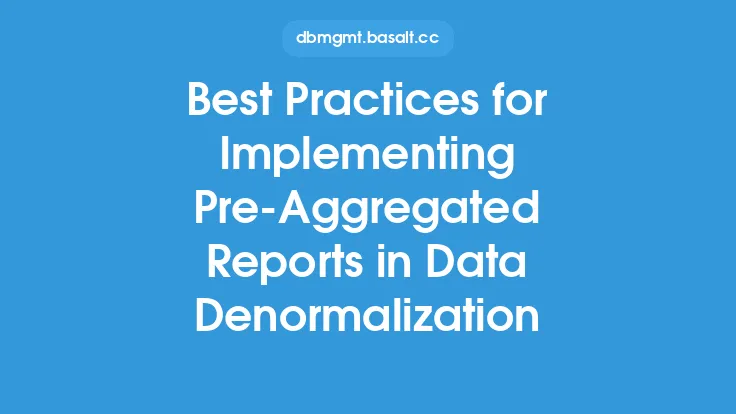When it comes to data analysis, one of the most critical factors that can make or break the efficiency of the process is query performance. Data marting, a subset of data denormalization, plays a vital role in improving query performance by providing a simplified and optimized view of the data. In this article, we will delve into the best practices for data marting that can significantly enhance query performance, making it an indispensable resource for data analysts, architects, and engineers.
Introduction to Data Marting
Data marting is a process of creating a subset of data from a larger database, typically designed to support a specific business function or department. The primary goal of data marting is to provide fast and efficient access to data, enabling users to perform complex queries and analysis without affecting the performance of the main database. By denormalizing the data and pre-aggregating it, data marting reduces the complexity of queries, resulting in faster execution times and improved overall performance.
Designing a Data Mart for Query Performance
To design a data mart that optimizes query performance, several factors need to be considered. First and foremost, it is essential to identify the specific business requirements and the types of queries that will be executed on the data mart. This will help determine the optimal data structure, indexing strategy, and aggregation levels. A well-designed data mart should have a simple and intuitive schema, with a minimal number of tables and joins, to reduce the complexity of queries. Additionally, the data mart should be designed to support the most common query patterns, with pre-aggregated data and optimized indexing to minimize the need for runtime calculations.
Data Modeling and Normalization
Data modeling and normalization are critical components of data mart design. A data mart should be designed with a focus on query performance, rather than data normalization. This means that the data should be denormalized to reduce the number of joins and improve query execution times. However, it is essential to strike a balance between denormalization and data consistency, to ensure that the data remains accurate and reliable. A good data modeling approach should include techniques such as star and snowflake schema design, which can help to optimize query performance by reducing the number of joins and improving data aggregation.
Indexing and Partitioning
Indexing and partitioning are two essential techniques that can significantly improve query performance in a data mart. Indexing helps to speed up query execution by providing a quick way to locate specific data, while partitioning enables the database to focus on a specific subset of data, reducing the amount of data that needs to be scanned. A well-designed indexing strategy should include a combination of column-store and row-store indexes, depending on the query patterns and data distribution. Partitioning, on the other hand, should be based on the most common query filters, such as date or region, to minimize the amount of data that needs to be scanned.
Data Aggregation and Summarization
Data aggregation and summarization are critical components of data marting, as they enable users to perform complex queries and analysis on large datasets. By pre-aggregating data and storing it in a summarized form, data marting can significantly reduce the complexity of queries and improve query performance. Techniques such as roll-up and drill-down aggregation can help to provide a hierarchical view of the data, enabling users to analyze data at different levels of granularity. Additionally, data summarization techniques such as grouping and pivoting can help to reduce the amount of data that needs to be scanned, resulting in faster query execution times.
Query Optimization
Query optimization is a critical component of data marting, as it enables users to execute complex queries and analysis on large datasets. A well-designed query optimization strategy should include techniques such as query rewriting, indexing, and caching, to minimize the amount of data that needs to be scanned and reduce the complexity of queries. Additionally, query optimization tools such as query analyzers and execution planners can help to identify performance bottlenecks and optimize query execution plans. By optimizing queries, data marting can significantly improve query performance, enabling users to perform complex analysis and reporting on large datasets.
Data Mart Maintenance and Refresh
Data mart maintenance and refresh are critical components of data marting, as they ensure that the data remains accurate and up-to-date. A well-designed data mart maintenance strategy should include techniques such as data validation, data cleansing, and data refresh, to ensure that the data remains consistent and reliable. Additionally, data mart refresh should be scheduled regularly, to ensure that the data remains up-to-date and reflects the latest changes. By maintaining and refreshing the data mart regularly, users can ensure that the data remains accurate and reliable, and that query performance remains optimal.
Best Practices for Data Marting
To ensure optimal query performance, several best practices should be followed when designing and implementing a data mart. First and foremost, it is essential to identify the specific business requirements and query patterns, to design a data mart that meets the needs of the users. Additionally, a well-designed data mart should have a simple and intuitive schema, with a minimal number of tables and joins, to reduce the complexity of queries. Indexing and partitioning should be used to optimize query performance, and data aggregation and summarization should be used to reduce the complexity of queries. Finally, query optimization and data mart maintenance and refresh should be performed regularly, to ensure that the data remains accurate and up-to-date, and that query performance remains optimal.
Conclusion
In conclusion, data marting is a critical component of data denormalization, and plays a vital role in improving query performance. By designing a data mart with a focus on query performance, using techniques such as data modeling, indexing, and partitioning, and optimizing queries, users can significantly improve query execution times and enable complex analysis and reporting on large datasets. By following best practices for data marting, users can ensure that the data remains accurate and up-to-date, and that query performance remains optimal, making it an indispensable resource for data analysts, architects, and engineers.





